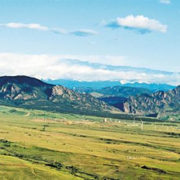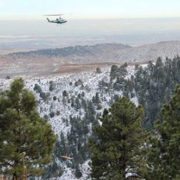Starting the Discussion: Regional Conservation Networks
by Vicky Gits
“We need to find out what’s on your radar screen and get those things on the map,”—Tom Hoby.
Jefferson County Open Space is encouraging conservation enthusiasts to think regionally and get together with like-minded individuals across county and organizational lines.
In pursuit of the goal Jeffco Open Space conceived and hosted a “Conservation Café,” to explore the idea of creating “conservation networks,” specifically four such networks, targeting four major drainage regions in Jefferson County.
Ralston Creek, Clear Creek, Bear Creek and Deer Creek potential conservation areas were discussed.
PLAN Jeffco and The Jeffco Outdoors Foundation joined in as sponsors of the half-day event and participated in the planning process. The idea for the event grew out of a proposal by PLAN Jeffco on how to implement the acquisition strategies in the recently adopted Open Space Master Plan.
Forty-five individuals involved in recreation, parks, nature preserves and watershed joined Open Space staff for the gathering November 20, 2014 at the Boettcher Mansion on Lookout Mountain. See side bar for the 35 organizations attending.
The goal was to introduce the concept of regional conservation networks and explore the possibility of creating regional conservation networks in Jefferson County.
The structure of the gathering was “World Café style.” Participants rotated among four conversation centers covering four geographic areas of concern: Ralston Creek, Bear Creek, Clear Creek and Deer Creek, all of which run from the western border of the county to the east.
Organizations represented at the Conservation Cafe:
Bear Creek Watershed Association
Boulder County Parks and Open Space
Clear Creek County
Clear Creek Land Conservancy
Coalition for the Upper South Platte
Colorado Department of Health and Environment
Colorado Ecological Services Office
Colorado Open Lands
Colorado State Land Board
Conifer Area Council
Denver Botanic Gardens at Chatfield
Denver Mountain Parks
Denver Mountain Parks Foundation
Denver Water
Douglas County Open Space & Natural Resources
Evergreen Audubon Society
Federal Highway Administration
Foothills Park & Recreation District
Golden Gate Canyon State Park
Great Outdoors Colorado
Jeffco Outdoors Foundation
Jefferson County Conservation District
Jefferson County Nature Association
Ken Caryl Master Association
City of Lakewood
Lariat Loop National Scenic Byway
National Park Service
Jeffco Open Space Advisory Committee
PLAN Jeffco
Rocky Mountain Wild
Table Mountains Conservation Fund
Team Evergreen
U. S. Army Corps of Engineers
Water Action Network
City of Westminister
Executive director Tom Hoby set the stage by introducing the concept of regional conservation and describing the successful Chatfield Basin Conservation Network (CBCN), which was created in 2006 and functioned for about six years before disbanding. (See Chatfield Basin Conservation Network Green Infrastructure System: Conservation Connections for Nature and People, May 2006.
The CBCN consisted of 75 partners, including several developers. As a group they worked together to identify important conservation priorities, such as preserving trails and wildlife corridors around Chatfield Basin.
The network received a $6 million grant from Great Outdoors Colorado, and partners acquired the property that resulted in Hildebrand Park, created a trailhead at County Line Road between Broadway and Santa Fe, and created the Audubon Nature Center at Chatfield State Park.
Hoby cited the example of the creation of the Front Range Mountain Backdrop, an $80 million investment, as another successful regional effort.
The main purpose of conservation networks is to identify various lands that, in the opinion of the network members, need to be preserved for various reasons. The second part is to demonstrate the need to the general public.
“Jeffco Open Space’s guiding philosophy is we only deal with willing buyers and fair market values,” Hoby said.
“How much land is enough? It’s difficult to quantify. Some people think we have enough and others think there is never enough,” Hoby said.
“We need to say why that’s important, categorically, whatever those things might be. Conservation is an ongoing process. Not something we are going to be done with some day. We can slice and dice them however we want to. The ones we identify could be a starting point or expanded,” he said.
“We need to find out what’s on your radar screen and get those things on the map,” Hoby said.
After the introductions, participants broke up into groups to discuss their areas for 15 minutes per group.
These breakout groups viewed large tabletop maps and made notes on their goals such as creating trail connections from Meyer Ranch to Beaver Ranch, From Flying J Open Space Park to Evergreen and from Flying J to Conifer High.
Overall, there was a concern for protecting areas identified as especially valuable for biodiversity purposes by scientists from Colorado State University under the Colorado Natural Heritage study program that identifies the rarest and most threatened species and plant communities: Survey of Critical Biological Resources Jefferson County, Colorado.
The Ralston Creek Region has some efforts that are underway. The Rocky Mountain Greenway project builds on President Obama’s “America’s Great Outdoors Initiative’ intended to connect communities to the nature that surrounds them. This initiative includes connecting the Rocky Mountain Arsenal to Rocky Mountain National Park.
Associated with the Rocky Mountain Greenway is the desire to realize the full alignment of the Colorado Front Range Trail. Identification of opportunities to fill gaps in this important north-south trail alignment across Colorado is most important in this northern portion of Jefferson County, leading into Boulder County where there are many on-road and off-road cycling possibilities.
View sheds were discussed as critically important to preserve along both the Indiana and Highway 93 corridors. Protecting the Ralston creek watershed and water quality in the corridor were found to be important.
The Ralston Creek Region is rich in natural resources, including the Preble’s Jumping Mouse, raptors of all kinds, sensitive native prairie habitat, and open expanses which enable wildlife movement. Protecting areas of high biodiversity is paramount in this region.
Conversation on the Clear Creek region referred to preserving the view north from I-70 to Centennial Cone. Large parcels in the watershed such as the Goltra property east of Centennial Cone and north of Clear Creek Canyon Park need to be protected.
Maintaining momentum on the Peaks to Plains Trail project along Clear Creek was discussed along with protecting gaps along the corridor with emphasis on wildlife habitat and movement.
A shuttle from the Jeffco Courts & Administration building along the Lariat Loop was mentioned as a means of allowing more people to enjoy the parks and cultural resources in the area.
Suggested opportunities for preservation of lands in the Bear Creek Region include private lands west of Matthews/Winters Park, east of Red Rocks Park, and south of Lair o’ the Bear Park. Water quality was discussed by the articipants for this region along with forest health and wildfire mitigation. Also discussed was the expansion of Firewise practices on all properties within the region.
Additional trails to connect Evergreen with Morrison and Conifer were discussed.
Conservation partnerships were the focus of discussion about the Deer Creek Region. Because of the many areas of high biodiversity, there is need for a preservation effort that focuses on plant communities, watershed/source water protection, restoration, and recreation.
The major water corridors, including the South Platte, Buffalo Creek, and Deer Creek offer opportunities for large-scale restoration. Trail opportunities include along the South Platte and connecting Conifer with the parks in the Region.
At the end of the morning, JCOS planning director Amy Ito said the division staff was committed to choosing one of the four areas and organizing and leading a conservation network group for that area. It would be up to participants to organize other groups.
PLAN Jeffco’s Margot Zallen urged the JCOS staff to think about how many opportunities might be lost if the staff doesn’t think about the rest of the county at the same time.
Open Space is planning to start with a Network focusing on the Deer Creek Region. There are at least 56 partner agencies in this region and many efforts already are underway.
The staff report on the conservation Café is posted on the Open Space web site under Meetings.











